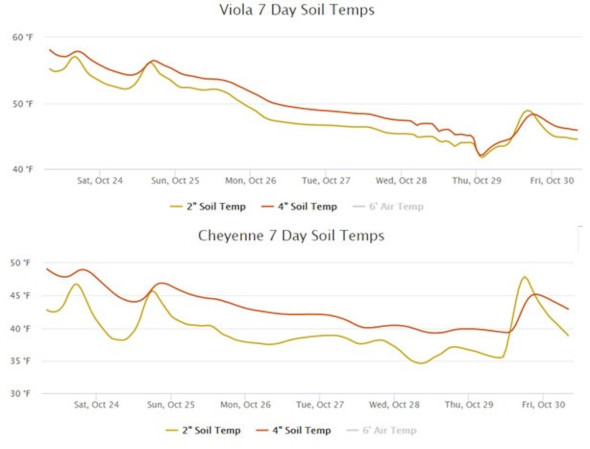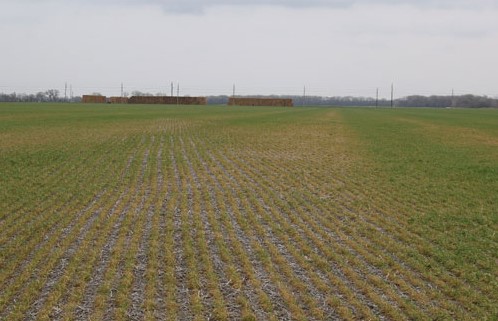By Romulo Lollato and Christopher Redmond
The sharp drop in temperatures across Kansas observed in late October 2020 could have different consequences to the wheat crop, varying from no impact to the crop, to some injury in particular fields. Average temperatures dropped to as low as 0 degrees F on October 27 in northwest Kansas (Figure 1). In regions where temperatures were lowest, there was also some snow accumulation that ranged from 0 to 5 inches across the state (Figure 1).
Figure 1. Minimum air temperatures observed on October 27 (upper panel, courtesy of Kansas Mesonet), and cumulative snowfall during October 26 (lower panel, courtesy of NOAA).
The actual consequences of this temperature drop should be field specific, depending on the region within the state and several other factors. The snowfall will be important to help buffer possible injuries resulting from cold temperatures. When more than 2-3 inches of snow is accumulated on the soil surface, it helps buffer temperature changes in the soil surface by avoiding large changes in soil temperature and thus protecting the wheat crop. While the drop in air temperature also led to a drop in soil temperature, the minimum soil temperatures never reached levels below 35 degrees F in northwest Kansas (where air temperatures reached 0 degrees F) or ~40 degrees F in south central Kansas (Figure 2). Another factor impacting the degree of damage from cold air temperatures to the wheat crop is topsoil moisture, which also affects the extent of change in soil temperature. The moisture level in the topsoil was very low across the entire state, with topsoil (2” depth) percent of saturation ranging from 24-44% prior to the drop in temperatures. Dry soils have a lower thermal buffer capacity compared to moist soils, and winter injury might be more pronounced. While the average soil temperatures followed a similar trend to that observed for air temperatures (Fig. 2), the minimum 2-inch soil temperatures measured across the state was about 35 degrees F in parts of southwest Kansas.

Figure 2. Average soil temperature at the 2-inch and 4-inch depth from 24 Oct to 30 Oct for Viola (south central KS, upper panel) and Cheyenne (northwest KS, middle panel). Minimum soil temperatures did not reach values lower than 28°F across the state. Data courtesy of Kansas Mesonet.
While the soil temperatures show in Figure 2 are relatively low, the snow fall helped avoid steeper drops in soil temperature and will certainly help buffer any negative effects of the sharp temperature drop. For parts of the state receiving less than ~2 inches of snow where air temperatures dropped below 15 degrees F and the wheat crop has just emerged, however, some damage might have occurred. This might be especially the case for fields planted in heavy no-till residue where the furrow might not have been closed properly at sowing, or where there was not good seed-soil contact. Under these circumstances, the lack of furrow closure results in a less protected seedling (and in some fields, crown) which might be more exposed to cold temperatures (Figure 3).
Producers are encouraged to start checking for possible injury on lower portions of the fields and especially in no-till fields with heavy residue in the near future, but no immediate damage will be apparent. The cold temperatures also will be more likely to cause injury to wheat if the plants were showing drought stress symptoms and soil temperature might have fallen below those shown on Figure 2, as dry soils will get colder more easily than wet soils. Additionally, the drier and looser the seed bed soil is, the greater the potential for the planting to be exposed to cold temperatures resulting in injury. Meanwhile, firmer and moister soils should help to minimize rapid fluctuations in soil temperatures allowing the wheat to better withstand cold temperatures.

Figure 3. Effect of soybean residue on wheat cold damage. Yellow portions of the field correspond to greater residue left by the combine at soybean harvest, and resulted in poorer seed-soil contact at wheat planting. As a consequence, the plants are more exposed to colder temperatures and potential injury. Photo provided by Romulo Lollato, K-State Research and Extension.
Another factor affecting wheat’s response to the cold is whether the wheat had time to become properly cold-hardened, which is likely not the case for the majority of the state due to the dry conditions at sowing delaying wheat emergence. In fact, many fields have not even emerged at this point or are just now starting to emerge.
In fields that have not yet emerged but in which seeds are already sprouted, no significant injury should be expected for two main reasons:
- Recently sprouted wheat generally handles temperatures above 5-10 degrees F well, and soil temperatures never reached those levels.
- Recently sprouted wheat is still below the soil surface and the warm soil temperatures will likely help buffer the seedling from being damaged by the cold.
In fields where the crop has already emerged, temperatures of around 15 degrees F or less can injure the newly emerged wheat, and these limits decrease as the crop progresses to tillering later in the fall and become more cold-hardy. Thus, some fields in western Kansas where the crop has recently emerged, especially the northwest part of the state, could sustain some level of damage. We likely won’t know for sure until temperatures warm up and give us an opportunity to scout.
If fields were affected, the first symptom will be burndown of the wheat from these cold temperatures as shown in Figure 3. For fields that were planted early to take advantage of the mid-September precipitation and were able to start tillering prior to the cold snap, the wheat might already be “bigger-than-normal” and the plants may look “rough” with a lot of brown, dead-looking foliage on the soil surface. That doesn’t mean the plants are dead. The important factor will be whether the crown below the soil surface remains alive. Having a well-developed secondary root system will help the plants survive.
In summary, the extent of the damage resulting from the late-October 2020 cold snap can be a concern in certain scenarios described above. The most concerning scenarios would be those in which less than ~2 inches of snowfall were received, coupled with a just recently emerged crop and air temperatures less than 15 degrees F.
Source : ksu.edu